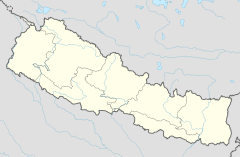Halesi-Maratika Caves
This article includes a list of general references, but it lacks sufficient corresponding inline citations. (January 2023) |
| Halesi-Maraktika Caves | |
|---|---|
Haleshi Mahadevstan | |
 The main Halesi-Maratika Cave (Halesi Mahadev Temple) | |
| Religion | |
| Affiliation | Hinduism, Buddhism, Kiratism |
| District | Khotang |
| Province | Province No. 1 |
| Deity | Mahadev |
| Location | |
| Location | Halesi Tuwachung Municipality |
| Country | Nepal |
| Geographic coordinates | 27°11′24″N 86°37′21″E / 27.19006°N 86.622391°E / 27.19006; 86.622391 |
| Architecture | |
| Type | Naturally formed |
The Halesi-Maratika Caves (also the Haleshi Mahadev temple) are located next to the village of Mahadevasthan, in the Khotang District of eastern Nepal, 3,100 ft. – 4,734 ft. above sea level. The cave and temple are about 185 km south west of Mount Everest. The temple is a venerated pilgrimage site for Hindus, Buddhists and Kirat.[1] The caves are called the Halesi Mahadev Temple by Hindus who associate them with Mahadeva, a form of Shiva; while they are known as the sacred place to Buddhists, who consider them to be the caves associated with the legend of Padmasambhava.[2] The Kirati Rai of the region worship Halesi as an ancestral deity of the community. The Kirat mundhum, a rich oral tradition of the Kirats, manifests that their ancestor Raechhakule (Khokchilipa) also known as Hetchhakuppa used to stay inside the Halesi cave in the remote past. For that reason, the Kirat/Rais consider Halesi as their ancestral place.[1]
Geology and environment
This cave is 67 feet below the surface. It is a tourist destination. Its entrance is shaped as a half moon and faces towards the east. It has a round shape, with a diameter of 193 feet, with another, separate, cave lying beneath. The floor is 223 feet in circumference.[citation needed] The location of this cave lies between the holy rivers Dudh Koshi and Sun Kosi. This place is usually cold and rainy. Nowadays it is accessible by motorcycles and jeeps.[citation needed]
History
The caves of Halesi-Maratika are referred to in Himalayan literature as far back as the 12th century. Kathang Zanglingma, a biography of Padmasambhava, a terma revealed and transmitted by Nyangrel Nyima Ozer, describes the original events which made the Maratika caves a sacred place for Vajrayana practitioners.[3]
Religious significance
.jpg/440px-Haleshi_Mahadevsthaan,Khotang_(1).jpg)
The most famous natural cave in Khotang District is said to have been the abode of Mahadeva while hiding away from the monster Bhasmasur. It is an important pilgrimage center located in east Nepal for both Hindus and Buddhist. The cave is nicknamed 'the Pashupatinath of the east'. Well-attended religious fairs are observed here on Shivaratri and Bala Chaturdashi.[4]
In Buddhism
Mandarava and Padmasambhava realized a number of terma that had been elementally encoded in the cave by dakini Sangwa Yeshe. These terma numbers among the longevity teachings of Buddha Amitabha, and were given at the behest of Bodhisattva Avalokiteswara. It is here, at the cave, that Mandarava and Padmasambhava attained the Vidyadhara of longevity (or long life). [citation needed]
In Hinduism
Hindus from India come to visit here after climbing many hills. Many people come here from places like Ladania and Jayanagar during the month of Shrawan to pray to Haleshi Mahadev. It is believed that Lord Shiva hid from the demon Bhasmasur for 6,000 years in this cave.[citation needed]
During the holidays of Bhasmasur,[citation needed] Rama Navami,[5] and Ganesh Chaturthi,[citation needed] fairs and festivities are held in the area.
References
- ^ a b Khatry & Shrestha 2014.
- ^ Phuntsok n.d.
- ^ Buffetrille 1994, p. [page needed].
- ^ Buffetrille 2012.
- ^ Khatri 2016.
Works cited
- Buffetrille, Katia (1994). The Halase-Maratika Caves (Eastern Nepal): A sacred place claimed by both Hindus and Buddhists. Pondy Papers in Social Sciences. Vol. 16. Pondicherry: Institut Français de Pondicherry – via Academia.edu.
- Buffetrille, Katia (2012). "Low Tricks and High Stakes Surrounding a Holy Place in Eastern Nepal: The Halesi-Māratika Caves". In Buffetrille, Katia (ed.). Revisiting Rituals in a Changing Tibetan World. Brill's Tibetan Studies Library. Vol. 31. Leiden/Boston: Brill. pp. 163–208. ISBN 978-9004232174. ISSN 1568-6183 – via Academia.edu.
- Khatri, Dilip (April 15, 2016). "Devotees throng Halesi Mahadev on Ram Nawami". The Himalayan. Retrieved 2023-01-08.
- Khatry, Prem K.; Shrestha, Hari Prasad (July 2014). "The Sacred Complex of Halesi: A Hindu, Buddhist and Kirata Spiritual Interface (Draft Final Report)" (PDF). SAARC Cultural Centre Sri Lanka. Retrieved 2023-01-08.
- Phuntsok, Dorje (n.d.). "The Great Maratika Cave of Immortality". Levekunst. Retrieved 2023-01-08.
